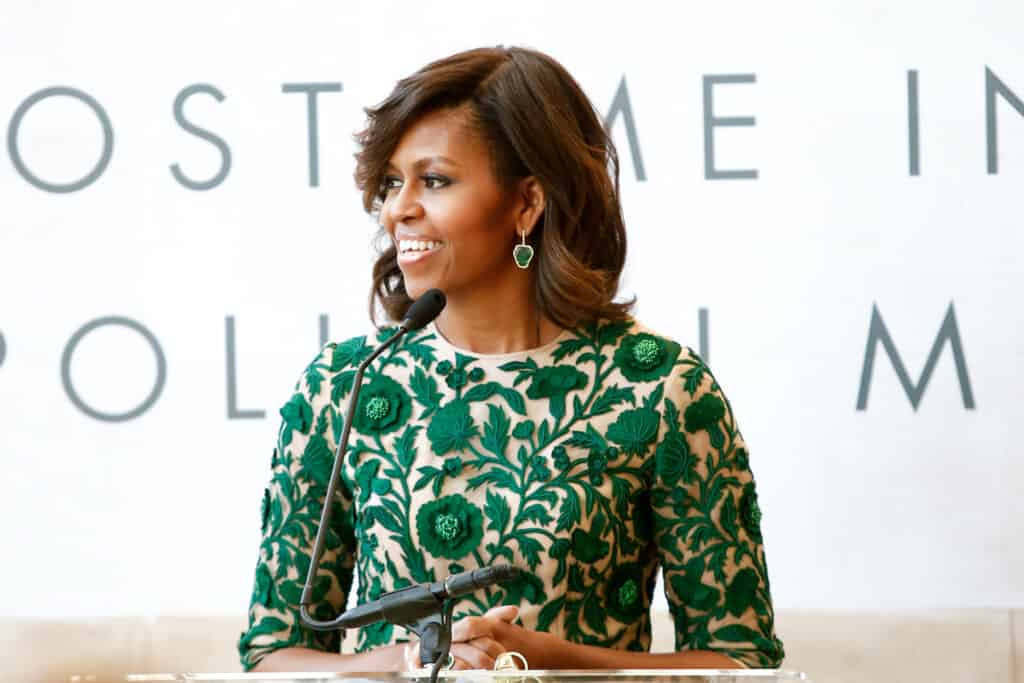It’s no secret that many professional black women wear wigs or weaves to cover their natural hair. Since Michelle Obama’s hairstyle was consistently a straight bob for her eight years as FLOTUS, does she also wear a wig?
Michelle Obama does not wear a wig. During her time in the White House as the First Lady, she would blow-dry and straighten her hair. In 2018, after the release of her book Becoming, she wore her hair with its natural curls on the cover of Essence Magazine and fans praised her for letting it fly free.

You can read more below about the stereotypes surrounding black professional women’s hair and how Michelle Obama has since worn her hair to help quash the stigma.
Stereotypes Surrounding Hair
A lot of different companies and workplaces have come under fire in recent years for perpetuating stereotypes surrounding black women’s hair. One of those companies was Google.
They came under fire back in 2016 because the Twitter user, @BonKamona, discovered something pretty shocking. She pointed out that when searching “unprofessional hairstyles for work,” photos of black women wearing their natural hair were populated amongst photos of actual inappropriate hairstyles.
The discovery brought a lot of heat to the search engine, but that’s just one example of the issues that black women face at work in regards to their hair. Honestly, it’s not just at work, it’s throughout their lives.
Jenae Holloway at Glamour Magazine does a fantastic job of pointing out just how bad the stigma surrounding black hair has become. In her article, I Thought We Were Done Policing Black Hair, she says that this stigma has “penetrated generations of black women.”
Holloway even goes on to say that “My own grandmother used to ask whether I was ‘wearing my hair like that’ when I went to a nice event with naturally curly hair.” It doesn’t end there either.
In another article with Glamour titled The Natural Hair Movement: A Fight for Your Right to Curls, Holloway elaborates on the stereotypes that surround black hair. She talks about how a school in South Africa tried to implement restrictions on braid thickness and cornrow designs.
How ridiculous is that? Restrictions like these then force women to chemically alter their natural hair.
The stereotypes are so bad that women like Maxine Waters, a well-respected congresswoman had to deal with racist hair comments from Bill O’Reilly.
In 2017, when O’Reilly was asked to comment on her remarks, he said he couldn’t focus on what she was saying because he was too distracted by her “James Brown wig.” Insert eye-roll emoji here.
O’Reilly later apologized, but at what cost to perpetuating yet another stereotype surrounding black women’s hair?
Watch the below interview with Chimamanda Ngozi Adichie who talks about Michelle Obama’s hair as the FLOTUS.
Michelle Obama Helps Break Stigma
A question you may be asking yourself then, is how does this all relate back to Michelle Obama with her straightened bob? A lot actually.
For the eight years that Michelle Obama was the First Lady of the United States, she wore her hair in pretty much one style: a flat-ironed bob. Even though she is a black woman with naturally curly hair, she was a black businesswoman.
In that sense, she was still probably stuck to having to maintain a certain image. She even told 2 Dope Queens that “But this wasn’t just a first lady journey. This is a black professional women’s journey.”
She actually had to have a hair strategy as the FLOTUS. Once she was out of her role though, Michelle Obama had a lot more freedom to wear her hair in its natural state.
While on vacation in 2017, Michelle Obama wore her hair naturally, tied back with a hair elastic, and many fans just lost it. A lot of them said that they wished she had worn it this way while at the White House.
Then in 2018, Obama appeared on the cover of Essence with her naturally curly hair. She has since appeared on many occasions rocking her natural hair, which is a big step towards breaking the hair stigma.
She’s sending the message that hers and any black woman’s natural hair looks professional. Also, allowing the next generation to feel that they can accept their natural hair, as well as helping to create a conversation around a topic that many people are unaware of.